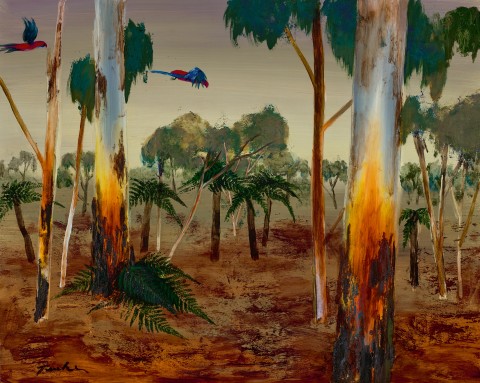PARROTS IN BUSH, c.1973
ALBERT TUCKER
oil on board
60.5 x 76.0 cm
signed lower left: Tucker
Private collection
Leonard Joel, Melbourne, 31 July 1990, lot 140
Joseph Brown Gallery, Melbourne
The Cbus Collection of Australian Art, Melbourne, acquired from the above on 2 August 1990
The Reading Room: The Cbus Collection of Australian Art, Latrobe Regional Gallery, Victoria, 9 November 2013 – 20 April 2014
Colour and Movement, Benalla Art Gallery, Victoria, 19 February – 9 June 2016
on long term loan to Geelong Art Gallery, Victoria
Nainby, B., Stanhope, Z., and Furlonger, K., The Cbus Collection of Australian Art, in association with Latrobe Regional Gallery, Melbourne, 2009, pp. 15, 102 (illus.), 225
Albert Tucker’s return to Australia in 1960 from an extended time living abroad coincided with a long overdue reassessment and appreciation of his work on home soil, particularly in his hometown of Melbourne. Key to this was the timing of Richard Haese’s seminal exhibition Rebels and Precursors: Aspects of Painting in Melbourne 1937-1947, that was shown at the National Gallery of Victoria in 1962. Haese’s exhibition showcased the work of artists such as Arthur Boyd, John Perceval, Sidney Nolan, Danila Vassilieff and Tucker, among others, introducing their work to a new generation of artists, and to a wide public audience. Having come to maturity experiencing the Great Depression and two World Wars, and having long fought for critical recognition and acceptance, Tucker was now regarded as a significant senior artist and truly part of the canon of recent Australian art history.
In the mid-1950s Tucker was introduced by Italian artist Alberto Burri to polyvinyl acetate (PVA) – a material that was to revolutionise his practice for a time. As he recalled: ‘I met Alberto Burri in 1953 – 54 because he lived not far from me. He spoke English quite well. When I went around his studio … I noticed he had a whole stack of tins – blue cans – of stuff called Vinivyl. He said: ‘It’s marvellous stuff… it does everything that I want it to do…’ He showed me big built-up masses of it which had dried right out. I tested it and you could mortar to an inch thick and if there was a big enough sheet of it, it could still bend, it had this flexibility and leathery toughness to it…’1
PVA allowed Tucker to build up the surface of his works without using masses of oil paint, which was expensive, and importantly, to bind other materials – sand, earth and wood, for example, into the picture plane. This was transformational, enabling him to bring a tactile sculptural quality to his ‘Antipodean Heads’ and later, to the Australian landscapes that he began to paint after he moved in 1961 to a property in rural Hurstbridge, north-east of Melbourne.
The artist’s new-found immersion in the bush enabled him to capture not only the colour and searing light of the Australian landscape, but also its heat and sounds – we can almost hear the screech of the rosellas as they fly overhead. Settling into this new period of artistic notoriety in mid-life, Tucker clearly relished the experimentation and joy of painting that his bush homeland inspired. As he said: ‘I was still in my stage of being completely overawed by the old-fashioned gum tree. After thirteen years absence you realise what a unique, prehistoric beast it is. It had all these marvellous qualities. I had a fresh view of it, and so I started painting gum trees when they were extremely unpopular. They were regarded as an academic idea to be avoided at all costs.’2
1. Albert Tucker interview with James Mollison, 1990 quoted in Fry, G., Albert Tucker, The Beagle Press, Sydney, 2005, p.136
2. James Gleeson Interviews: Albert Tucker [transcript], 2 May 1979, James Gleeson Oral History Collection, National Gallery of Australia, https://nga.gov.au/media/dd/documents/tucker.pdf, accessed 29 May 2020
KELLY GELLATLY
